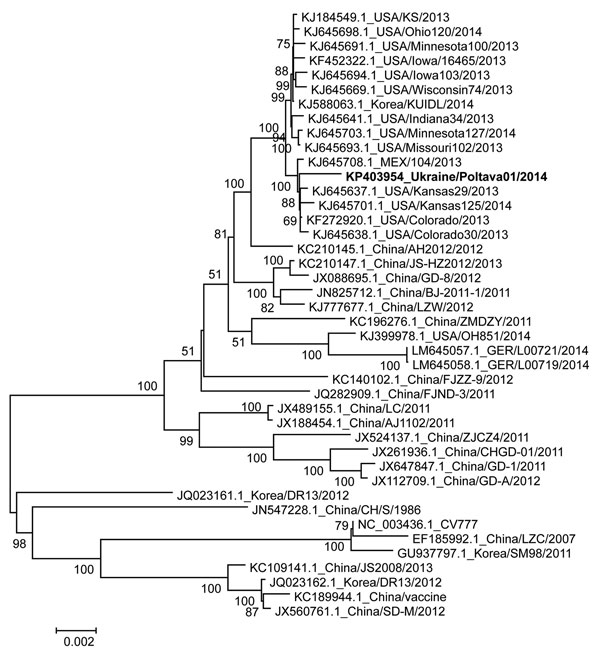Volume 21, Number 12—December 2015
Dispatch
Porcine Epidemic Diarrhea Virus among Farmed Pigs, Ukraine
Figure

Figure. Phylogenetic analysis of the full-length genome of the porcine epidemic diarrhea virus (PEDV) Ukraine/Poltava01/2014 (bold text). The full-length genomes of PEDV were aligned by using the MegAlign software of the DNASTAR Lasergene Core Suite (DNASTAR, Inc., Madison, WI, USA) and phylogenetic analysis was done by using MEGA 5.2 software (13). The tree was constructed by using the neighbor-joining method and 1,000 bootstrap replications. Only bootstrap values of more than 50% are shown in the figure. Each virus on the tree is represented by accession number, strain, and year of sample collection. Ukraine/Poltava01/2014 clusters in close proximity to recent strains in the United States other than the Ohio851 variant, and both are substantially genetically different from the previous European variants, such as the prototype strain CV777, which is embedded in another cluster. Scale bar indicates nucleotide substitutions per site.
References
- Wood EN. An apparently new syndrome of porcine epidemic diarrhea. Vet Rec. 1977;100:243–4. DOIPubMedGoogle Scholar
- Song D, Park B. Porcine epidemic diarrhea virus: a comprehensive review of molecular epidemiology, diagnosis, and vaccines. Virus Genes. 2012;44:167–75. DOIPubMedGoogle Scholar
- Sun RQ, Cai RJ, Chen YQ, Liang P, Chen D, Song C. Outbreak of porcine epidemic diarrhea in suckling piglets, China. Emerg Infect Dis. 2012;18:161–3. DOIPubMedGoogle Scholar
- Stevenson GW, Hoang H, Schwartz KJ, Burrough ER, Sun D, Madson D, Emergence of Porcine epidemic diarrhea virus in the United States: clinical signs, lesions, and viral genomic sequences. J Vet Diagn Invest. 2013;25:649–54. DOIPubMedGoogle Scholar
- Wang L, Byrum B, Zhang Y. New variant of porcine epidemic diarrhea virus, United States, 2014. Emerg Infect Dis. 2014;20:917–9. DOIPubMedGoogle Scholar
- Vlasova AN, Marthaler D, Wang Q, Culhane MR, Rossow KD, Rovira A, Distinct characteristics and complex evolution of PEDV strains, North America, May 2013-February 2014. Emerg Infect Dis. 2014;20:1620–8. DOIPubMedGoogle Scholar
- Pasick J, Berhane Y, Ojkic D, Maxie G, Embury-Hyatt C, Swekla K, Investigation into the role of potentially contaminated feed as a source of the first-detected outbreaks of porcine epidemic diarrhea in Canada. Transbound Emerg Dis. 2014;61:397–410. DOIPubMedGoogle Scholar
- Hanke D, Jenckel M, Petrov A, Ritzmann M, Stadler J, Akimkin V, Comparison of Porcine Epidemic Diarrhea Viruses from Germany and the United States. Emerg Infect Dis. 2015;21:493–6. DOIPubMedGoogle Scholar
- Van der Wolf PJ, Van Walderveen A, Meertens MN, Van Hout AJ, Duinhof TF, Geudeke MJ, First case of porcine epidemic diarrhea (PED) caused by a new variant of PED virus in the Netherlands. In: Proceedings of the 7th European Symposium of Porcine Health Management, 2015 Apr 22–24, Nantes, France. Brussels: European College of Porcine Health Management and the European Association of Porcine Health Management; 2015. p. 79.
- European Food Safety Authority. Scientific opinion on porcine epidemic diarrhoea and emerging porcine deltacoronavirus. EFSA Journal. 2014;12:3877.
- Carvajal A. Diagnostic and surveillance of porcine epidemic diarrhea. In: Proceedings of the 7th European Symposium of Porcine Health Management; 2015 Apr 22–24, Nantes, France. Brussels: European College of Porcine Health Management and the European Association of Porcine Health Management; 2015. p. 56–7.
- Zerbino DR, Birney E. Velvet: algorithms for de novo short read assembly using de Bruijn graphs. Genome Res. 2008;18:821–9. DOIPubMedGoogle Scholar
- Tamura K, Peterson D, Peterson N, Stecher G, Nei M, Kumar S. Molecular evolutionary genetics analysis using maximum likelihood, evolutionary distance, and maximum parsimony methods. Mol Biol Evol. 2011;28:2731–9. DOIPubMedGoogle Scholar
- Alonso C, Goede DP, Morrison RB, Davies PR, Rovira A, Marthaler DG, Evidence of infectivity of airborne porcine epidemic diarrhea virus and detection of airborne viral RNA at long distances from infected herds. Vet Res. 2014;45:73. DOIPubMedGoogle Scholar
- Williamson S, Strugnell B, Thomson J, Webster G, McOrist S, Clarke H. Emergence of severe porcine epidemic diarrhea in pigs in the USA. Vet Rec. 2013;173:146–8. DOIPubMedGoogle Scholar